 |
  |
 |
  |
Kalpana: A Bharatanatyam dancer in Paris - Éliane Béranger Photos courtesy: Kalpana July 22, 2022 From an early age, Kalpana was influenced by the spirit of tradition, the western one. Both her parents were musicians, amateurs with a high level. Kalpana's birth name is Martine Métayer, and she was born in Paris. She duly learned flute for several years in a conservatoire. Her sister is a professional cello player. When Martine discovered Bharatanatyam by taking part in Malavika's [1} workshop (1977), she faced a totally new and unexpected form of art where dance, theatre, music and poetry merged and offered a full aesthetic and intimate experience. After some classes with Malavika and Shakuntala [2] she felt she had found the path she would follow for life. Moreover, starting from this moment she could explore the subtlety and the tiny nuances between two ways of practicing the same style. 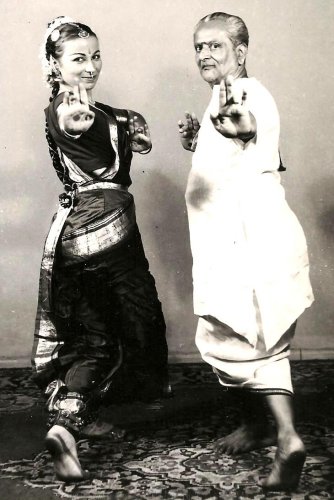 Kalpana with her guru V.S. Muthuswamy Pillai At first, she managed to afford on her own, a short stay with Guru Muthuswamy Pillai (1980). She gained confidence that Bharatanatyam was the place where she felt alive. Two years later she obtained a scholarship (ICCR India and Ministry of Foreign Affairs - France). She could finally stay for several years in India, during which she was lucky enough to learn singing with Kamakshi Kuppuswamy and abhinaya with Kalanidhi Narayanan. Martine became Kalpana on her arangetram day on 29th November 1983 at Mylapore Fine Arts in Madras. 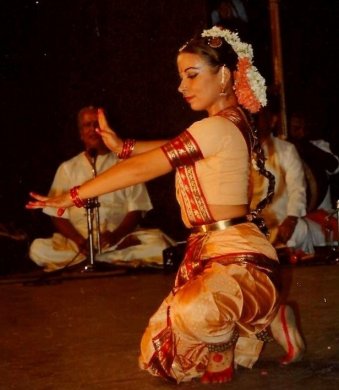 Kalpana's arangetram Career Fais-moi cygne in French, a word game on the assonance between cygne ('swan') and signe ('sign'): fais-moi signe meaning in French 'let me know' is Kalpana's latest piece, created several months ago. The choreography goes through the several academic dance and music styles Kalpana performed along her career. At the last minute, the Bharatanatyam appears in its whole subtlety: when Saint-Saëns' music starts, Kalpana wearing her traditional costume, brings a perfect Bharatanatyam expression of the famous ballet piece [3]. Such a nuanced and strong work leads a western audience to a deep emotion… up to suspend the clapping for a few seconds to keep the pure rasa, as I could myself remark many times. With such a piece, Kalpana's talent reaches a full maturity. As Kalpana explained to me, the very secret and deep principle underlying her whole work is: "I wish to take part in the set of my life with the dance style I master and I deeply love." With such a strong and clear principle Kalpana could bring her art at its best by sharing her researches with modern or experimental dance choreographers, such as Andy de Groat. Kalpana's personal researches range from Bharatanatyam performances to a pure Bharatanatyam piece, choreographed as a duet (something very new at that moment [4]), with Dominique Delorme, À fleur de peau (1995). Some other 'French-Indian' artistes have taken part in Kalpana's personal work bringing an 'outside look', such as Maitreyi [5]. Mostly, Kalpana's work uses different music styles or poetry recited on stage. Many of the French traditional Indian dancers in all styles, used to perform both maintaining a pure style and trying to enhance their performances through personal creations. Kalpana never made a misstep in her choices. I wish to stress this point, since I carefully follow her career. A very rich career indeed, as the short list joined to this text allows to see. Transmission The other point I would like to emphasise is the way Kalpana manages the transmission of her art. She opened her first classes in 1992. Hamsasya is the name she gave to her project and for the following 30 years she has given the best teaching to all her students, even the youngest (Kalpana accepts children as young as nine years old). As soon as they reach a strong basic level and start learning choreographies, they can experience the nuances of Kalpana's gurus. For the more advanced students, Kalpana invites other teachers from France or India to give classes and workshops for them. Kalpana encourages her more advanced students to participate in the Bharatanatyam workshops and master classes, when ARTA (Association Research Traditions of Acting - Paris) invites master teachers, such as Vidhya Subramanian. She came several times to ARTA, recently in April '22, on Kalpana's initiative. This 30th birthday year, ARTA has offered Kalpana to do three workshops together with her friend the French Carnatic singer Emmanuelle Martin.  Photo: Yannick Cormier Several of her first students are now professional artistes. Kalpana is one of the very few French-Indian dancers who can live on her art income. Keeping all that in mind, she deserved and obtained, in 2020, the ICCR Distinguished Alumni Award. Kalpana has been able to manage such a long professional balance, by her open-minded artistic style both in teaching and performing. By enlarging her Bharatanatyam repertoire through modern music, artistic encounters and researches, she could preserve her passion, her deep will to strengthen her basic formation. I do not hesitate to say that she has thus prevented with a real intelligence the stagnation of falling into routine, and also find (or maybe save) a larger and motivated public for the art of Bharatanatyam. Some of Kalpana's major and inventive contributions to Bharatanatyam: Already in 1985, her first solo, still deeply linked to tradition, is noticed by the critique in Avignon Off. 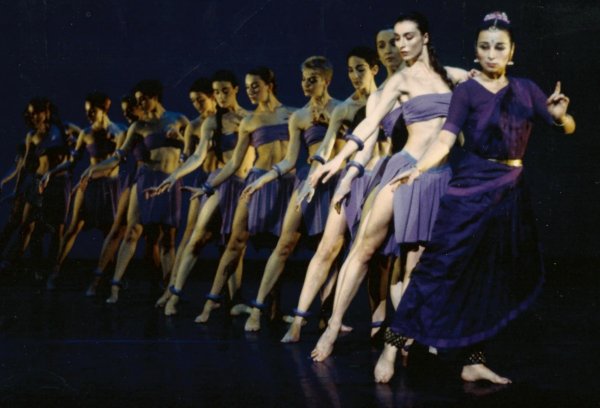 Kalpana in La Bayadère 'Figures' (1988) shows her first personal thinking on gesture and movement in dance. She performed it on many European stages, up to in Finland. This choreography was very appreciated by the American choreographer Andy de Groat, who invited Kalpana to join his company for his new piece 'The Bayadère' in 1992 and for a long European tour (1992/1994). In 1995, Andy de Groat composed a solo specially for Kalpana, 'Ma déesse SDF.' Within this company Kalpana met Dominique Bousquet, a contemporary dancer: together they created a duet 'Michaud-Mi-froid' based upon Henri Michaud's poems. This choreography was invited to India for a tour sponsored by the Alliance Française. The National Indian TV channel Doordarshan made a recording of this piece. Les Tournées JMF (Jeunesses Musicales de France) produced a two years tour (1993/95) in France, for children and young people: a pedagogical performance 'Dance and Music of India'; Kalpana was accompanied by mridangam player Ravi Dharmaraja. Let us remember also two experiences of 'dancing character' incorporated in a theatrical performance. A long French tour with the company Théâtre du Monde. Then, 'Jan Undo' staged by Michael Lonsdale. 'Solos à 2' was her first creation without visible reference to Bharatanatyam: live music was performed by the flautist Pierre-André Valade. 'Parava Illei' (2015) looks back to Kalpana's own career, a dancing story of her different encounters. 'Kothatei' (2016) choreographed on an original music by Giacinto Scelsi tries to represent Shiva as being dismayed by the chaos of our world. The first part shows authentic Muthuswamy Pillai's choreographies. 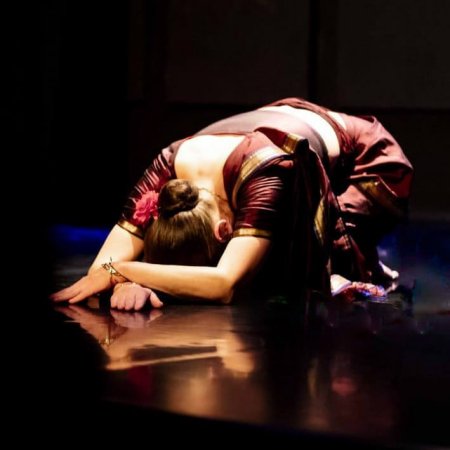 Fais moi cygne Photo: Anthe Cintrat Kalpana's research is grounded on the relation of dance/music: three different pieces were created with Daniel Petitjean: 'Ragalypso' and 'Etudes'; a long collaboration shared with Flor Capo, a Flamenco dancer, led to 'Femmes Jasmin' (2012). Her latest creation 'Fais-moi cygne' "is the desire to share with the public my way of living the Bharatanatyam today. The margam has taken another form where every chosen piece is the result of a strong encounter with a choreographer and (or) a musical work. That piece is the trigger and from there, a path was drawn almost in spite of me, with the thread of the traditional margam in filigree." Footnotes 1. Malavika was one of the first French Bharatanatyam dancers; she lived in Madras and learnt from K. Ellappa Mudaliar. 2. Shakuntala, a French dancer, disciple of Muthuswamy Pillai who presented Kalpana to her guru. 3. « La Mort du cygne » Michel Fokine, created by Anna Pavlova in 1905, out of "Le cygne", 13th movement of Le Carnaval des Animaux by Camille Saint-Saëns, a piece that each ballerine wants to perform as a peak of her career. 4. Especially concerning the use of space, and music of different styles, including silence. 5. Maitreyi, French disciple of K. Ellappa Mudaliar. 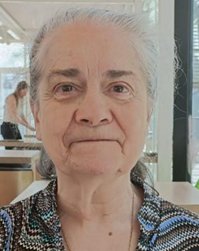 Eliane Béranger is a dance anthropologist/Indian dance specialist - PHD in 2004, Paris University – Member from the beginning of Mandapa's crew. Post your comments Please provide your name and email id along with your comment. All appropriate comments posted with name and email id in the blog will also be featured in the site. |